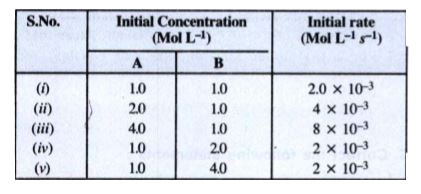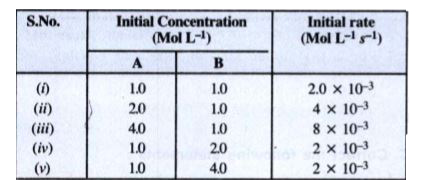For the reaction A+B→C+D, the initial rate for different reactions and initial concentration of reactants are given below:

(i) What is the overall order of reaction ?
(ii) Write the rate law equation.
On doubling the concentration of reactant A (keeping the concentration of reactant B constant), the rate of reaction is getting doubled which indicates that the reaction is first order with respect to reactant A. Also, on doubling the concentration of reactant B (keeping the concentration of reactant A.constant, there is no effect on the reaction rate which indicates that the reaction is zero order with respect to reactant B.
So, the rate equation for the reaction can be written as:
Rate =k[A]1[B]0
(i) The overall order of the reaction is 1 + 0 = 1 that is first order reaction.
(ii) Rate law of equation :
Rate =k[A]1[B]0 or rate = k[A]
Topper's Solved these Questions
- CHEMISTRY-2019BOOK - ICSECHAPTER - CHEMISTRY-2019EXERCISE - Question (Answer the following questions)
5 Videos
- CHEMISTRY-2018BOOK - ICSECHAPTER - CHEMISTRY-2018EXERCISE - Question (Answer the following question)
5 Videos
- CHEMISTRY-2020 BOOK - ICSECHAPTER - CHEMISTRY-2020 EXERCISE - Question (Answer the following question)
4 Videos
Similar Questions
Consider the reaction, A+B→C+D.
The initial rate for different initial concentrations of the reactants are given below :

What is the overall order ?
View SolutionConsider the reaction, A+B→C+D.
The initial rate for different initial concentrations of the reactants are given below :

What is the overall order ?
View SolutionConsider the reaction, A+B→C+D.
The initial rate for different initial concentrations of the reactants are given below :

What is the overall order ?
View SolutionConsider the reaction, A+B→C+D.
The initial rate for different initial concentrations of the reactants are given below :

Write the rate law equation.
View SolutionConsider the reaction, A+B→C+D.
The initial rate for different initial concentrations of the reactants are given below :

Write the rate law equation.
View SolutionConsider the reaction, A+B→C+D.
The initial rate for different initial concentrations of the reactants are given below :

Write the rate law equation.
View SolutionConsider the reaction, A+B→C+D.
The initial rate for different initial concentrations of the reactants are given below :

Calculate the rate constant.
View SolutionConsider the reaction, A+B→C+D.
The initial rate for different initial concentrations of the reactants are given below :

Calculate the rate constant.
View SolutionConsider the reaction, A+B→C+D.
The initial rate for different initial concentrations of the reactants are given below :

Calculate the rate constant.
View SolutionConsider the reaction, A+B→C+D.
The initial rate for different initial concentrations of the reactants are given below :

Suggest a possible mechanism.
View Solution
